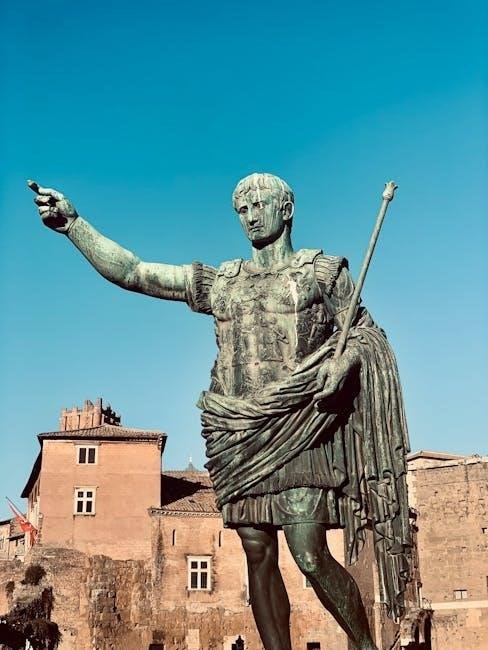
William Shakespeare’s Julius Caesar is a tragic play based on real events, exploring the conspiracy against Caesar, led by Brutus and Cassius, in 44 BC Rome․
1․1 Historical Context
Shakespeare’s Julius Caesar is set in ancient Rome during a time of political turmoil․ The play is based on real events, drawing from historical accounts of Caesar’s rise to power and his eventual assassination․ Caesar’s dictatorship and the senators’ fear of his growing influence sparked the conspiracy led by Brutus and Cassius․ The play captures the tension between Caesar’s ambition and the Roman Republic’s struggle to maintain its democratic ideals, reflecting the political instability of the late Roman Republic․
1․2 Shakespeare’s Inspiration
Shakespeare’s primary source for Julius Caesar was Thomas North’s translation of Plutarch’s Lives of the Noble Greeks and Romans․ This historical account provided the playwright with detailed insights into Caesar’s life, his assassination, and the political dynamics of ancient Rome․ Shakespeare drew inspiration from these events to craft a drama exploring themes of ambition, power, and betrayal, shaping a timeless tragedy that resonates with universal human experiences․

Plot Summary
Shakespeare’s Julius Caesar recounts Caesar’s triumphant return to Rome, his assassination by Brutus and Cassius, and the ensuing power struggle that leads to the conspirators’ downfall․
2․1 Act I: The Conspiracy Begins
The play opens with Julius Caesar’s triumphant return to Rome after defeating Pompey․ Tribunes Flavius and Marullus disperse a celebrating crowd, while Cassius begins manipulating Brutus, sowing seeds of distrust in Caesar․ A soothsayer warns Caesar to “beware the Ides of March,” but Caesar dismisses the omen․ Cassius’s persuasive arguments ignite Brutus’s fears of Caesar’s rising power, setting the stage for the conspiracy’s formation․
2․2 Act II: The Assassination
Caesar’s wife, Calpurnia, has ominous dreams, urging him to stay home․ However, Decius manipulates him into attending the Senate․ There, Brutus and Cassius lead the conspirators in stabbing Caesar to death․ Despite a soothsayer’s warning to “beware the Ides of March,” Caesar is caught off guard․ His last words, “Et tu, Brute?” reflect his shock at Brutus’s betrayal․ The assassination marks a pivotal moment in Rome’s political turmoil․
2․3 Act III: The Aftermath


Mark Antony delivers a powerful oration at Caesar’s funeral, using emotional manipulation and Caesar’s bloodstained mantle to sway the crowd against the conspirators․ The plebeians, enraged, seek revenge, leading to chaos and violence․ Meanwhile, Antony, Lepidus, and Octavius form an alliance to confront Brutus and Cassius․ The act highlights the political turmoil and power vacuum following Caesar’s death, setting the stage for further conflict and shifting alliances․
2․4 Act IV: The Power Struggle
Octavius, Antony, and Lepidus form the Second Triumvirate, vowing to avenge Caesar and destroy Brutus and Cassius․ The conspirators, now in Greece, face internal tensions as Brutus and Cassius argue over strategy and funds․ Despite their differences, they prepare for battle, while Antony and Octavius march toward them․ The act intensifies the political and military conflict, showcasing the shifting alliances and the relentless pursuit of power in Rome’s chaotic landscape․
2․5 Act V: The Final Confrontation
The battle of Philippi marks the climax as Brutus and Cassius face Antony and Octavius․ Despite initial successes, the conspirators are defeated․ Cassius, believing all is lost, takes his own life, followed by Brutus․ Antony praises Brutus as “the noblest Roman of them all,” while Octavius and Antony emerge victorious, solidifying their power and ending the conspiracy․ The act concludes with the triumph of Caesar’s allies and the tragic demise of the conspirators․

Main Characters
The play centers around Julius Caesar, the ambitious Roman leader, Brutus, the noble yet conflicted conspirator, Cassius, the manipulative mastermind, and Mark Antony, Caesar’s loyal ally․
3․1 Julius Caesar
Julius Caesar, the dominant figure, returns to Rome in triumph after defeating Pompey’s sons․ His rising popularity and perceived ambition spark fear among senators․ Despite warnings, Caesar dismisses the soothsayer’s caution and is assassinated by Brutus and Cassius․ His death reshapes Rome’s political landscape, leaving a legacy of power and ambition․
3․2 Brutus
Brutus, a noble and honorable Roman senator, is torn between loyalty to Caesar and his fear of tyranny․ Convinced by Cassius, he joins the conspiracy, believing Caesar’s death will restore Rome’s republic․ His internal conflict and moral dilemma drive his actions, making him a tragic figure․ Brutus’s idealism and sense of duty ultimately lead to his downfall, as his decisions spark chaos and destruction․
3․3 Cassius
Cassius, a cunning and ambitious senator, is the mastermind behind the conspiracy against Caesar․ Driven by jealousy and a desire to prevent Caesar’s dictatorship, he skillfully manipulates Brutus into joining the plot․ Cassius’s persuasive nature and strategic thinking make him a key figure in the assassination․ However, his envy and resentment toward Caesar’s rise to power ultimately lead to his own downfall, revealing his complex and flawed character․
3․4 Mark Antony
Mark Antony, Caesar’s loyal ally and a skilled orator, emerges as a pivotal figure in the play’s second half․ After Caesar’s assassination, Antony delivers a powerful eulogy that turns public opinion against the conspirators․ His emotional speech, filled with rhetorical brilliance, ensures Caesar’s legacy endures and sets the stage for Antony’s rise to power․ Antony’s loyalty and political cunning make him a formidable opponent in the ensuing power struggle․

Themes
The play explores themes of ambition, loyalty, betrayal, fate, and power, highlighting the moral complexities of political intrigue and the consequences of human decisions․
4․1 Ambition and Power
The play delves into the destructive nature of ambition, as Caesar’s rise to power sparks fear among senators․ Cassius manipulates Brutus by appealing to his republican ideals, fearing Caesar’s potential dictatorship․ Caesar’s ambition blinds him to warnings, while Brutus’s conflicted desire for power and honor leads to tragic consequences․ The theme highlights how unchecked ambition can destabilize societies and lead to downfall, as seen in Caesar’s assassination and the ensuing chaos․
4․2 Loyalty and Betrayal
Loyalty and betrayal are central themes, as Brutus’s betrayal of Caesar exemplifies the tragic consequences of conflicted allegiances․ Brutus, driven by a misguided sense of honor, justifies his betrayal as a sacrifice for Rome’s freedom․ Cassius manipulates Brutus’s loyalty, exploiting his fear of Caesar’s rising power․ Meanwhile, Antony’s unwavering loyalty to Caesar contrasts sharply with the conspirators’ treachery, highlighting the moral complexity of their actions and the devastating impact of betrayal on relationships and society․
4․3 Fate and Free Will
The interplay between fate and free will underscores the tragedy, as characters confront destiny’s inevitability․ Caesar’s disregard for the soothsayer’s warning highlights fate’s inescapable nature․ Brutus and Cassius, believing their actions are driven by free will, are instead guided by fate’s design․ Their choices, though seemingly voluntary, align with the prophecy, illustrating how human decisions intertwine with a predetermined course of events, ultimately sealing their doom and reinforcing the futility of resisting destiny․

Historical Accuracy
Shakespeare’s Julius Caesar blends historical facts with creative liberties, drawing from Plutarch’s accounts but altering details for dramatic effect, maintaining the core of Caesar’s tragic downfall authentically․
5․1 Real-Life Events
Shakespeare’s Julius Caesar is rooted in historical events, including Caesar’s triumphant return to Rome after defeating Pompey’s sons and his subsequent assassination on the Ides of March․ The conspiracy, led by Brutus and Cassius, was driven by fears of Caesar’s growing power․ The play incorporates real-life figures and events, such as Caesar’s wife Calpurnia’s ominous dreams and the soothsayer’s warning, creating a blend of history and drama that shaped Rome’s political landscape․
5․2 Dramatic Liberties
Shakespeare took creative liberties to enhance the play’s drama, such as condensing timelines and inventing characters like Decius Brutus․ While historically accurate in many aspects, the play amplifies Calpurnia’s role and Caesar’s defiance․ The aftermath of Caesar’s death was also dramatized for emotional impact, blending fiction with fact to highlight themes of ambition and betrayal, making the story more engaging for audiences․

Play Structure
The play is divided into five acts, each highlighting key events: Caesar’s triumph, the conspiracy, his assassination, the power struggle, and the final confrontation․ Shakespeare uses dramatic techniques like soliloquies and omens to build tension and explore themes․
6․1 Acts and Scenes
The play is structured into five acts, each advancing the plot and exploring themes․ Act I introduces Caesar’s triumph and the forming conspiracy․ Act II depicts Brutus’s decision to join the conspirators and Caesar’s assassination․ Act III follows Antony’s rise and the aftermath of Caesar’s death․ Act IV shows the power struggle between Antony and the conspirators․ Act V concludes with the final confrontation and the deaths of Brutus and Cassius, completing the tragic cycle․
6․2 Dramatic Techniques
Shakespeare employs soliloquies, omens, and rhetorical speeches to heighten tension and explore characters’ motivations․ Soliloquies, like Brutus’s internal conflict, reveal deep emotional struggles․ Omens, such as Calpurnia’s dreams, foreshadow tragic events․ Rhetorical speeches, notably Antony’s funeral oration, showcase persuasive power and manipulation․ These techniques amplify the play’s dramatic impact, creating a rich exploration of ambition, loyalty, and fate․
Political and Moral Implications
The play explores the consequences of political ambition and the moral dilemmas of assassination, questioning the ethics of removing a leader for the “greater good․”
7․1 The Struggle for Power
The play highlights the intense power struggle in Rome, as senators fear Caesar’s rising dominance․ Brutus and Cassius conspire to assassinate Caesar, believing his death will restore the Republic․ However, their actions spark a brutal power vacuum, leading to Antony and Octavius’s rise․ The struggle reflects the moral complexities of ambition, loyalty, and betrayal, ultimately ending the Roman Republic and ushering in the Empire․
7․2 Ethics of Assassination
The play examines the moral dilemmas surrounding Caesar’s assassination․ Brutus justifies the act as a noble sacrifice to save Rome from tyranny, while Cassius is driven by personal jealousy․ Their actions, however, lead to chaos and destruction․ Shakespeare raises questions about the ethics of political violence and whether the ends ever justify such extreme means, leaving audiences to ponder the true cost of their decision․

Resources for Further Study
Download free PDF summaries, study guides, and scripts of Julius Caesar for deeper analysis․ Explore eNotes, SparkNotes, and online scripts for comprehensive understanding and study materials․
8․1 PDF Summaries
Free PDF summaries of Julius Caesar are widely available online, offering concise analyses of each act and character․ These documents provide detailed overviews of the play’s themes, plot, and historical context․ Students and educators can download PDFs from reliable sources like eNotes, SparkNotes, or educational websites․ These summaries often include character analyses, key quotes, and study questions, making them invaluable for quick reference or in-depth study․
Download the full play summary here․
8․2 Study Guides
Study guides for Julius Caesar provide in-depth analyses, character insights, and thematic discussions․ Platforms like SparkNotes and eNotes offer comprehensive guides, including act-by-act breakdowns, essay topics, and historical context․ These resources are ideal for students preparing for exams or assignments․ Additionally, downloadable PDF guides often feature interactive elements, such as quizzes and summaries, to enhance understanding of the play’s complex themes and characters․
Access a detailed study guide here․